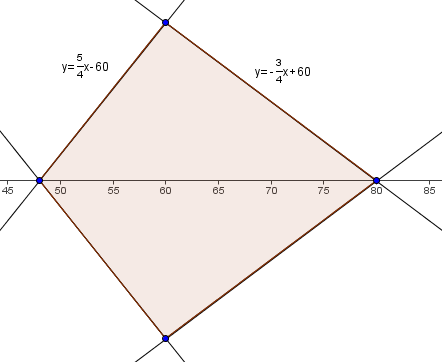Difference between revisions of "1987 AIME Problems/Problem 4"
(→Solution) |
(→Solution) |
||
| Line 10: | Line 10: | ||
*<math>x - 60 < 0</math>. Then <math>y = \frac{5}{4}x-60</math>. | *<math>x - 60 < 0</math>. Then <math>y = \frac{5}{4}x-60</math>. | ||
| − | The area of the region enclosed by the graph is that of the quadrilateral defined by the points <math>(48,0),\ (60,15),\ (80,0), \ (60,-15)</math>. Breaking it up into triangles and solving, we get <math>2 \cdot \frac{1}{2}(80 - 48)(15) = \boxed{480}</math>. | + | The area of the region enclosed by the graph is that of the quadrilateral defined by the points <math>(48,0),\ (60,15),\ (80,0), \ (60,-15)</math>. Breaking it up into triangles and solving or using shoelace, we get <math>2 \cdot \frac{1}{2}(80 - 48)(15) = \boxed{480}</math>. |
== See also == | == See also == | ||
Revision as of 23:34, 17 August 2017
Problem
Find the area of the region enclosed by the graph of ![]()
Solution
Since ![]() is nonnegative,
is nonnegative, ![]() . Solving this gives us two equations:
. Solving this gives us two equations: ![]() . Thus,
. Thus, ![]() . The maximum and minimum y value is when
. The maximum and minimum y value is when ![]() , which is when
, which is when ![]() and
and ![]() . Since the graph is symmetric about the y-axis, we just need casework upon
. Since the graph is symmetric about the y-axis, we just need casework upon ![]() .
. ![]() , so we break up the condition
, so we break up the condition ![]() :
:
 . Then
. Then  .
. . Then
. Then  .
.
The area of the region enclosed by the graph is that of the quadrilateral defined by the points ![]() . Breaking it up into triangles and solving or using shoelace, we get
. Breaking it up into triangles and solving or using shoelace, we get ![]() .
.
See also
| 1987 AIME (Problems • Answer Key • Resources) | ||
| Preceded by Problem 3 |
Followed by Problem 5 | |
| 1 • 2 • 3 • 4 • 5 • 6 • 7 • 8 • 9 • 10 • 11 • 12 • 13 • 14 • 15 | ||
| All AIME Problems and Solutions | ||
The problems on this page are copyrighted by the Mathematical Association of America's American Mathematics Competitions. 










